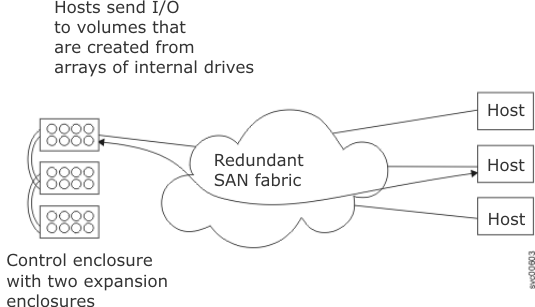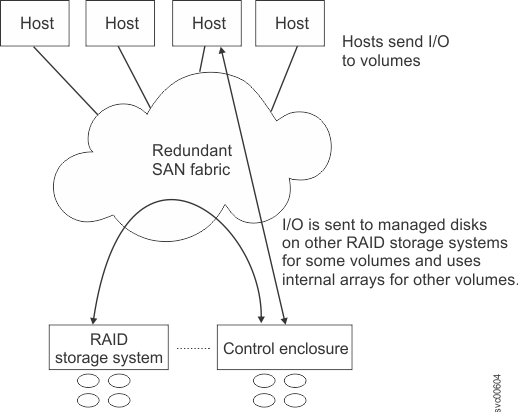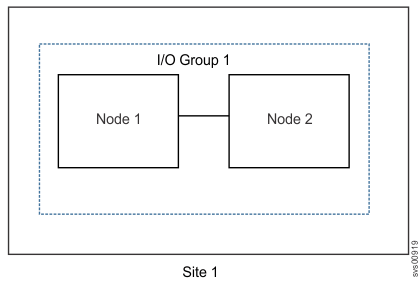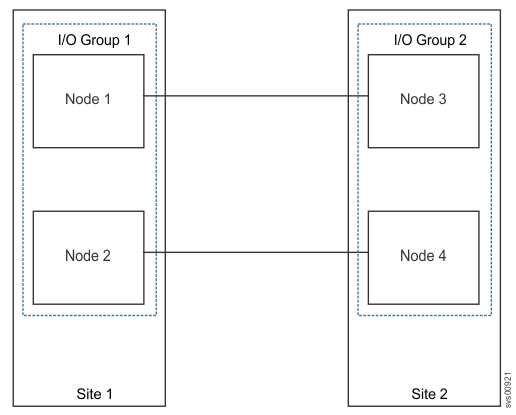The IBMLenovo Storage V7000 system is a virtualizing RAID storage system.
IBMSpectrum Virtualizesoftware
Lenovo Storage V7000 is built with Spectrum Virtualize™ software, which is part of the Spectrum Storage™ family.
Lenovo Storage V7000 hardware
The Lenovo Storage V7000storage system consists of a set of drive enclosures. Control enclosures contain disk drives and two node canisters. A collection of control enclosures that are managed as a single system is a clustered system.Expansion enclosures contain drives and are attached to control enclosures. Expansion canisters include the serial-attached SCSI (SAS) interface hardware that enables the node canisters to use the drives of the expansion enclosures.
Figure 1 shows the Lenovo Storage V7000 system as a traditional RAID storage system. The internal drives are configured into arrays and volumes are created from those arrays.

The Lenovo Storage V7000 system can also be used to virtualize other storage systems as shown in Figure 2.

The two node canisters in each control enclosure are arranged into pairs that are known as I/O groups. A single pair is responsible for serving I/O on a specific volume. Because a volume is served by two node canisters, there is no loss of availability if one node canister fails or is taken offline.
The Lenovo Storage V7000 system supports both regular and flash drives. In addition, a Lenovo Storage V7000 system without any internal drives can be used as a storage virtualization solution.
System topology
System management
The Lenovo Storage V7000 nodes in a clustered system operate as a single system and present a single point of control for system management and service. System management and error reporting are provided through an Ethernet interface to one of the nodes in the system, which is called the configuration node. The configuration node runs a web server and provides a command-line interface (CLI). The configuration node is a role that any node can take. If the current configuration node fails, a new configuration node is selected from the remaining nodes. Each node also provides a command-line interface and web interface for performing hardware service actions.
Fabric types
I/O operations between hosts and Lenovo Storage V7000 nodes and between Lenovo Storage V7000 nodes and RAID storage systems are performed by using the SCSI standard. The Lenovo Storage V7000 nodes communicate with each other by using private SCSI commands.
FCoE connectivity is supported on Lenovo Storage V7000 Gen1 models 2076-312 and 2076-324 if the system software is upgraded to version 6.4. A Lenovo Storage V7000 Gen2 model 2076-524 can have up to eight 10 Gbps Ethernet ports per control enclosure when two 4-port 10 GbE host interface adapters are installed.
Table 1 shows the fabric type that can be used for communicating between hosts, nodes, and RAID storage systems. These fabric types can be used at the same time.
| Communications type | Host to Lenovo Storage V7000 | Lenovo Storage V7000 to storage system | Lenovo Storage V7000 to Lenovo Storage V7000 |
|---|---|---|---|
| Fibre Channel SAN | Yes | Yes | Yes |
| iSCSI (1 Gbps Ethernet or 10 Gbps Ethernet) | Yes | No | No |
| Fibre Channel Over Ethernet SAN (10 Gbps Ethernet) | Yes | Yes | Yes |

